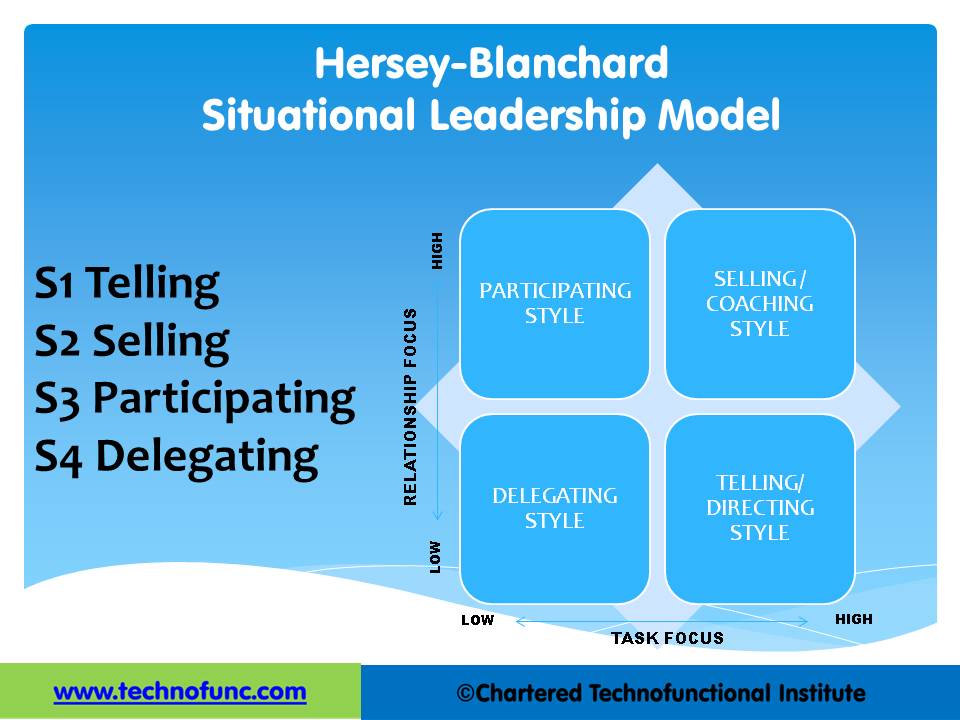- Home
- Business Processes
- Industry Knowledge
- Aerospace Industry
- Automotive Industry
- Banking Domain
- BFSI Industry
- Consumer/ FMCG Industry
- Chemicals Industry
- Engineering & Construction
- Energy Industry
- Education Domain
- Finance Domain
- Hospitality Domain
- Healthcare Industry
- Insurance Domain
- Retail Industry
- Travel and Tourism Domain
- Telecom Industry
- Leadership Skills
- eLearning
- Home
- Leadership
- Leadership Theories
- Situational Leadership - Application
Situational Leadership - Application
Situational Leadership Theories are well known and frequently used for training leaders within organizations. Practical application is how to choose the right leadership approach for the situation. The theory emphasizes leader flexibility and advises leaders to flex their style based on the followers' needs. Leaders must adapt their leadership style to fit the prescribed task, understanding given situation/maturity of followers.
How does this Approach Works?
The situational approach is constructed around the idea that different employees are at different level of development or maturity stages which represents the relative competence and commitment of subordinates for a given task. For leaders to be effective in such situations, it is essential that they determine where subordinates are on the maturity levels and adapt their leadership styles so that their style matches with the style of the development level and the followers can be benefited by the time and energy spent by the leader on it. In a way this approach is mutually beneficial to both follower and the leader as leader can also save his time and energy by understanding the maturity levels of the follower.
It is designed to increase the frequency and quality of conversations about performance and development between managers and the people they work with so that competence is developed, commitment is gained, and talented individuals are retained. Highlighted below are the key learning objectives from this theory:
- Develop an understanding of Interaction Styles and how this model can assist in gaining a greater understanding of yourself and others
- Understand how your preferences can influence you and others
- Understand the importance of adapting own interaction style to increase effectiveness
- Be able to diagnose others’ development levels and choose the appropriate leadership style
- Know why there is no best leadership or coaching style
- Learn to use a common language for coaching and developing others
- Understand the negative impact of over supervision and under supervision on others’ performance and morale
Steps to Apply Situational Leadership Model:
1. Determine the nature of the situation.
2. Understand the nature and complexity of the task at hand
3. Evaluate the skills and the desire of the subordinates to do the task being asked to perform.
4. Identify correctly the specific developmental level at which their subordinates are functioning.
5. Adapt his or her style to the prescribed leadership style represented in the table given in the previous article.
Practical Applications of the Situational Approach:
- This theory is well known and frequently used for training leaders within organizations.
- Perceived by organizations as an effective model for training people to become effective leaders and use the skills in workplace to solve common workplace conflicts.
- Highly practical, easy to understand, sensible theory that can be applied in a variety of settings and situations.
- Provide leaders with a valuable set of guidelines that can facilitate and enhance leadership.
- Emphasizes leader flexibility and recognizes that employees act differently with different tasks and leaders need to flex their style based on the situational or followers need.
- It is an encompassing model with a wide range of applications.

Related Links
You May Also Like
-
Trait Theory of Leadership is based on the assumption that people are born with inherited traits and some traits are particularly suited to leadership. The theory aims to discover specific leadership & personality traits and characteristics proven to predict the likelihood of success or failure of a leader.
-
Contingency Theories in Action
Contingency theory suggests matching the best leader to a specific situation based on situational factors and the leadership style. The practical application of theory can be done in various ways. The workplace example is to determine the best candidate for a given set of requirements using the LPC score. Applying the model to determine a leader's ability to adapt in the scenario of a new project etc..
-
Bass's Transformational Leadership Theory
Bass Transformational Leadership Theory is based on performance beyond expectations approach which defines four elements of transformational leadership. The 4 elements described by Bernard A. Bass in 1985 are Idealised Influence, Intellectual Stimulation, Individualised Consideration, and Inspirational Motivation. This study highlights four key insights about performance beyond expectations and associated criteria to measure it.
-
Leadership traits refer to personal qualities that define effective leaders. Here are the major leadership qualities that can make someone a good leader. Five key traits that are common in leaders can be learned and sharpened with time.
-
Michigan Leadership Studies led to behavioral Leadership Theory as a result of a leadership study conducted at the University of Michigan. Michigan studies identified three important behaviors of leadership called task-oriented behavior, relationship-oriented behavior, and participative leadership. Two leadership styles associated with studies are employee orientation and production orientation.
-
Continuum of leadership is a leadership theory based on the relationship between the level of freedom given to the team and the level of authority used by the manager. The chosen leadership style will depend on multiple factors, including the leader's personality.
-
The Valence Model of Leadership
The valence model of emergent leadership is based on a group-development sequence. As per the valence model, the process of emergent leadership passes through three distinct stages; Orientation, Conflict, and Emergence. Group members willingly start following and obeying the leader who has passed the "emergence threshold."
-
Normative leadership theories are built on moral principles and tell leaders how they ought to act. Victor Vroom formulated the normative model of leadership that specifically address leader behavior explicitly built on moral principles or norms. Normative leadership theories tell leaders how they should act to raise the moral performance inside the working group and manage their different responsibilities.
-
Team leadership theory is a recent leadership theory that does not discriminate between the leader and the other team members. The approach considers contributions from each team member to be critical for organizational success. This approach focused on the overall team effectiveness and team problems are diagnosed and action is taken to remediate weakness. This approach provides for taking corrective action when the leader deems necessary.
-
Hawthorne Studies - Leadership
The Hawthorne studies were conducted on workers at the Hawthorne plant of the Western Electric Company by Elton Mayo and Fritz Roethlisberger in the 1920s. This study established the behavioral change that happened due to an awareness of being observed, resulting in active compliance with the supposed wishes of researchers, because of special attention received, or positive response to the stimulus being introduced.
Explore Our Free Training Articles or
Sign Up to Start With Our eLearning Courses

About Us
Learning
© 2023 TechnoFunc, All Rights Reserved










